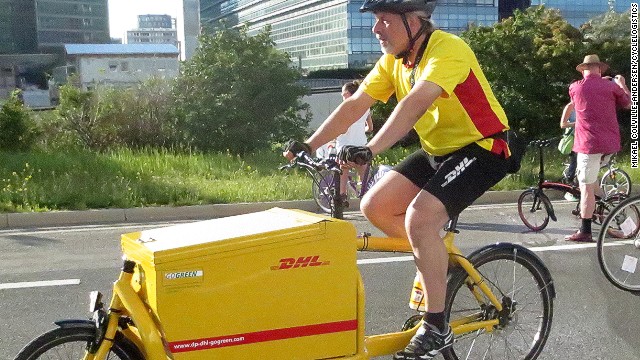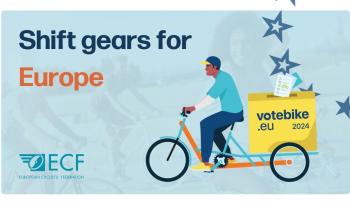
CNN Interview: A Follow-Up with Randy Rzewnicki
This past February CNN wrote about CycleLogistics and why bicycles are best when it comes to precious cargo. The article was a huge success with more than 5,1k social media users recommending it to their peers! Since you asked for it, we wanted to give you more on the topic.
From making cycling traffic safer by pushing for new regulations for lorries - as Road Safety officer Woolsgrove explains - to highlighting the unlimited ways to transport cargo by bike, CNN's story brought to the forefront ECF's and ECF's project-partners work in getting more people cycling more often (and carrying more things while doing so!).
We've edited the interview Randy Rzewnicki gave to CNN to get a behind-the-scenes scoop on how he views CycleLogistics in the grander scheme of things. If ever anyone was skeptical about the power of a bike to move mountains and change the world (or at least the urban city centre) - get them to read this:
CNN: Is it fair to say that EU policies are making it harder for companies to rely on freight trucks for their deliveries? If so, can you provide some examples?
"Cargo traffic is also a matter of transport planning like public transport or bicycle transport"
Rzewnicki: This is a tricky question. I have the feeling that the EU is just in the beginning of making urban logistics a topic. There are more indirect EU-related conditions like the pollution limits, e.g. for fine particulate matter and NOx, that make lorry transport and excessive car use a problem for many European cities. This leads to restrictions for motorized vehicles especially in inner cities or other sensitive areas.
EU Projects like C-Liege or Trailblazer also worked on the topic of making cities aware that cargo traffic is also a matter of transport planning like public transport or bicycle transport, because very few cities allocate staff resources to this field of activity.
What regions do you think have the furthest to go in this regard?
There is not yet a shining cargo bike city, like Groningen is one for bicycle transport or Zürich for public transport. But cities like Venice, for instance, show that limiting space conditions can lead to very intelligent logistics solutions that allow a high number of items transported on a small number of trips. This can also include cargo bikes.
 But of course European cities are just at the beginning of this movement, which will also make public space available for people instead of lorries. In a text for the Horizon2020 program, the EU says what it wants to do is "assess how the role of walking and cycling can be increased e.g. by human-centered environments...”. This means to shift city space from machine use to people use and CycleLogistics will play a role in that transformation.
But of course European cities are just at the beginning of this movement, which will also make public space available for people instead of lorries. In a text for the Horizon2020 program, the EU says what it wants to do is "assess how the role of walking and cycling can be increased e.g. by human-centered environments...”. This means to shift city space from machine use to people use and CycleLogistics will play a role in that transformation.
In the CycleLogistics project there is a clear commitment from cities like Cambridge, Milano or San Sebastian to go in that direction.
Utrecht is an example of a city that has been quite active for several years now with city logistics: Cargo Hopper and electric Beerboat have not only developed new vehicles but are also used more and more for taking goods out of and into the city. Also the type of goods is changing from parcels and drinks to heavy building goods and taking out waste.
Is there a limit on the types of good that can be transported by bike? Are there certain materials that could really only be delivered by car or truck (furniture, for instance)?
"80% of all purchases could be transported in a bike basket, 14% in a bike trailer/cargo bike and only 6% of all purchases are so big that a car is needed"
I would completely turn around the question. How small can a thing be that car-use for transporting it is justified? In a lot of cases it is not bigger than a package of cigarettes. This leads to the research carried out in Graz for supermarkets and shopping centers. 80% of all purchases could be transported in a bike basket, 14% in a bike trailer/cargo bike and only 6% of all purchases are so big that a car is needed.
I think it is much more important to think of everything that could be transported by bike than to think about the maximum size of an exotic transport. I would say if we shift every transport that can be easily shifted to the bicycle we have no problem anymore with these transports where the car or lorry is most appropriate.
While there are obviously some items that cannot be carried in a safe and efficient way by bike - for example, such as large white goods (fridges, freezers, cookers…), industrial machinery, furniture - a very large percentage of items transported by van or lorries are small packages, parcels, boxes which could easily be delivered by cargo bike.
What percentage of deliveries would you say can be made by bicycle?
I would say 25 % of all commercial deliveries can be done by cargo bike, but 77% of all motorized shopping trips in cities can be shifted to the bike. Combined, that means 51% of all urban motorized trips in cities that involve goods transport can be shifted to bike/cargo bike transport. So the potential is huge and cargo bike delivery shows us only a part of the picture. We should not forget the service and business trips that are commercial trips e.g. just transporting tools and not doing any delivery. About every second of these trips could be shifted to the bike/cargo bike.
What is the potential reduction in CO2 if the switch was made?
 If every potential trip from the potential was shifted, Europe would save about 37 Mio tons of CO2 per year. However, CO2 reductions are not the main argument for CycleLogistics.
If every potential trip from the potential was shifted, Europe would save about 37 Mio tons of CO2 per year. However, CO2 reductions are not the main argument for CycleLogistics.
CycleLogistics deals much more with improving the air quality in urban areas with high population density. In urban areas pollution and noise are great problems and CycleLogistics can contribute more here than to the reduction of CO2. In addition, CycleLogistics makes cities a better place to live in by improving the quality of public spaces.
What is the biggest challenge to the introduction of cargo bikes as an alternative means of transport?
I would say the biggest challenge is the public perception that cargo bikes are a realistic option for the transfer of light goods in urban areas.
"The biggest challenge is the public perception that cargo bikes are a realistic option for the transfer of light goods in urban areas"
Another challenge is developing and promoting the CycleLogistics concept and defining a credible implementation approach. As part of this, we must also make sure the message is being heard by relevant stakeholders who are able to influence and support a favorable environment.
Challenges are different for private and for commercial logistics, then. For private logistics, it is important to make people feel that many goods can be easily transported by bike and therefore to try it out and discover the advantages. Cities can help by improving cycling conditions (speed limits for car traffic, better cycle network etc.); supermarket chains can encourage customers to come by bike by offering products, improving conditions (bike parking) and offer trial programs.
For commercial logistics, the challenges are somewhat different. I think the main challenge is to make decision makers in cities aware that they don't have to be afraid of implementing restrictions for conventional cargo vehicles because cycle logistics will fill the gap.
How can these challenges be overcome?
Demonstrable case studies and pilots have been implemented throughout Europe. Big delivery companies (e.g. TNT, DHL, etc.) are recognising potential and implementing cargo bike solutions in difficult areas – this makes a big impact on the public perception of CycleLogistics and its viability.
If we manage to make use of cargo bikes (or trailer and panniers) trendy, as a sort of SUV for people who are smart, that would help acceptance a lot.
Developing and promoting the CycleLogistics concept is also necessary - the EU funded CycleLogistics project has been very successful in promoting what is possible. The project has had significant media coverage. This includes ensuring the message is being heard by relevant stakeholders. There is some evidence emerging that key stakeholders (eg. DG-Move, National Associations, etc) are recognising the potential.
To what extent could the integration of cargo bikes (both for individual use and deliveries) free up the roads in the future?
In congested areas cargo bike deliveries are as quick if not quicker than traditional motorized vehicles at a cost competitive price, meaning that customers can see a real business advantage in using cargo bikes for their local deliveries. The knock on effect is that the number of vans and taxis being used for deliveries is reduced.
"Customers can see a real business advantage in using cargo bikes for their local deliveries"
There is demonstrable evidence that international carriers are using cargo bike for deliveries to areas where they find access difficult due to restricted access, congestion, old towns/cities where streets are very narrow.
CycleLogistics can substantially reduce the road space used (20-30%) if we would look at that issue in a static way. But reality shows that every new, additional or free space offered on our roads is immediately filled by additional car traffic. This can be learned from every new tunnel, bridge or bypass road built. The gain of road space and public space by introducing CycleLogistics can only be realized if at the same time there is a restriction for motorized traffic.
Network/Project Involved:
- Log in to post comments
Contact the author
Recent news!
Contact Us
Avenue des Arts, 7-8
Postal address: Rue de la Charité, 22
1210 Brussels, Belgium










